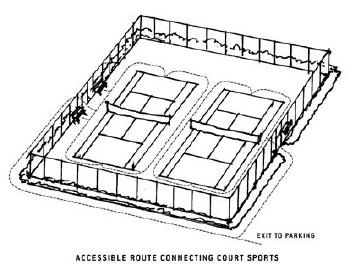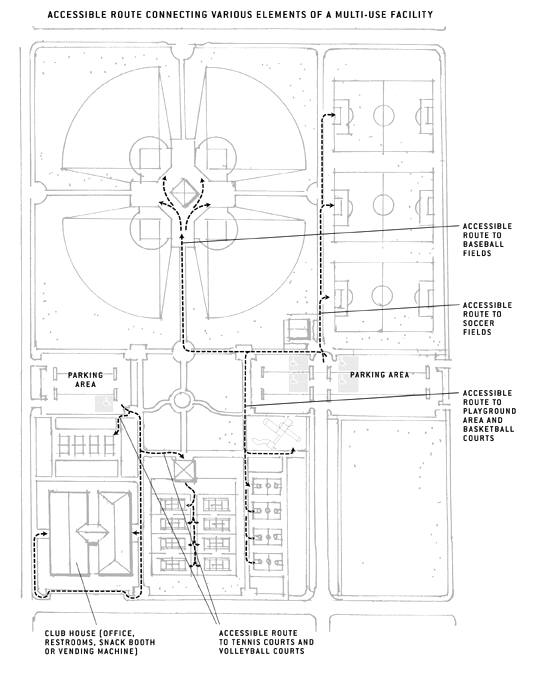Accessible Sports Facilities - A Summary of Accessibility Guidelines for Recreation Facilities
Accessible Routes
Accessible routes are continuous, unobstructed paths connecting all accessible elements and spaces of a building or facility. The accessible route must comply with ADAAG provisions for the location, width (minimum of 36 inches), passing space, head room, surface, slope (maximum of 1:12 or 8.33%), changes in level, doors, egress, and areas of rescue assistance, unless otherwise modified by specific provisions outlined in this guide. Facilities must provide accessible routes connecting all accessible elements and spaces within areas of indoor or outdoor sports activities. If not all elements need to be accessible, only those that are accessible must be connected with an accessible route. The guidelines apply to “fixed” facilities and elements. They do not cover equipment that is frequently moved. For example, a wrestling mat or badminton net may be portable and moved regularly.
Court Sports
Where courts are provided, an accessible route must connect each court. Accessible routes must comply with all ADAAG requirements, such as width and changes in level or surface, and must directly connect both sides of the court. Players must not be required to traverse through another court to get to the other side of their court. This is especially critical in sports like tennis, in which changing sides of the court is part of the game. No additional accessibility guidelines apply once on the court.
Areas of Sport Activities
An "area of sport activity" is a broad term intended to cover a diverse number of indoor and outdoor sports fields and areas. This includes, but is not limited to: basketball courts, baseball fields, running tracks, soccer fields, and skating rinks. The "area of sport activity" is "that portion of a room or space where the play or practice of a sport occurs." For example, football fields are defined by boundary lines. In addition, a safety border is provided around the field. Players may temporarily be in the space between the boundary lines and the safety border when they are pushed out of bounds or momentum carries them forward when receiving a pass. So in football, that space is used as part of the game and is included in the area of sport activity.
Accessible routes must connect each area of sport activity. Areas of sport activities must comply with all ADAAG requirements, except that they are exempt from the requirement that surfaces must be stable, firm, and slip resistant, and from the restrictions on carpets, grating, and changes in level. They are also exempt from restrictions on protruding objects. These provisions are not required inside of the area of sport activity since they may affect the fundamental nature of the sport or activity. For example, an accessible route is required to connect to the boundary of a soccer field, but there is no requirement to change the surface of a field to an accessible surface.
Where light fixtures or gates are provided as part of a court sport or other area of sport activity, they must comply with ADAAG provisions for controls and operating mechanisms, and for gates and doors.
Animal Containment Areas
If the public has access to an animal containment area, accessible routes must connect to each animal containment area. Examples may include petting zoos, petting farms, public pathways for viewing livestock display tents, or other areas where the public has access to animals. These areas must comply with all ADAAG requirements, except the requirements that surfaces be stable, firm, and slip resistant and the restrictions on changes in level since some surfaces need to be absorbent. Accessibility is not required in areas that are for animal handlers and not for public use.



User Comments/Questions
Add Comment/Question